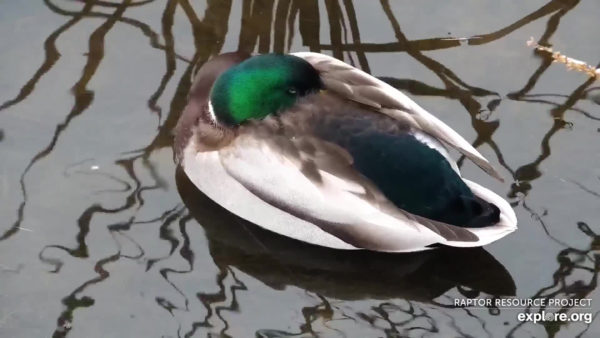Information About The Bird
Seen/Heard at
Decorah, Decorah North, Mississippi River Flyway, Great Spirit Bluff
Diet
The omnivorous Mallard Duck feeds on land or in shallow bodies of water. In the water, Mallards will tip forward or dabble to forage for aquatic vegetation including duckweed, arrowhead tubers, cattail roots and stems, reeds, wild rice, and bulrushes, as well as insect larvae, snails, young crabs, freshwater shrimp, clams, small fish, fish eggs, tadpoles, and worms. Mallards will also forage on the ground for earthworms, snails, wild millet, agricultural grains, and acorns, and will readily eat bread, popcorn, potato chips, and other offered or dropped human leftovers. Their diet varies widely with location, season, and food availability.
Dabbling ducks like Mallards require shallow water to feed and raise young. Since they don’t dive, they are unable to feed in deep water, although they can forage on land. Diving ducks like Mergansers can feed in deep water, but have a hard time foraging on land. You can learn more about waterfowl feeding adaptations here: http://www.ducks.org/conservation/waterfowl-research-science/waterfowl-feeding-adaptations.
Nesting
Mallard Ducks nest from early April through late September. A female duck builds a nest by dropping to the ground, digging with her feet, and rotating to create a shallow depression or scrape. Once the scrape is done, she pulls sedges, reeds, cattails, twigs, leaves, and other vegetation within reach to build walls and line the inside of her scrape. She pulls tall vegetation over the nest and plucks down from her breast to cover and conceal her eggs. Mallard ducks lay one to thirteen creamy to greyish/greenish eggs per clutch and produce one to two broods per year. The female incubates eggs for 23-30 days and young leave the nest shortly after hatching. To learn more, visit Cornell’s website.
Citations and attributions
Bird Range Maps of North America
Ridgely, R.S., T.F. Allnutt, T. Brooks, D.K. McNicol, D.W. Mehlman, B.E. Young, and J.R. Zook. 2003.
Digital Distribution Maps of the Birds of the Western Hemisphere, version 1.0. NatureServe, Arlington, Virginia, USA. Data provided by NatureServe in collaboration with Robert Ridgely, James Zook, The Nature Conservancy – Migratory Bird Program, Conservation International – CABS, World Wildlife Fund – US, and Environment Canada – WILDSPACE.
Web Link: http://bit.ly/2ynPQ5I
Birds of North America: https://birdsna.org/Species-Account/bna/species/mallar/introduction
Image of Mallard Ducks By Fcb981: https://commons.wikimedia.org/wiki/File:Male_and_Female_mallard_ducks.jpg from Wikimedia Commons
General Description
Male Mallards have a dark, iridescent-green head, a bright yellow bill, a slim white neck ring, brown upper parts, black rumps, and a blue wing patch. Female Mallards are mottled brown with orange and brown bills, a dark brown eye stripe, and a blue wing patch.
Migration
Mallards can be found at open water in Minnesota and Iowa year-round, although some winter ducks could be migrants from colder climates.
Measurements
Length: 19.7-25.6 in/50-65 cm
Wingspan: 32.3-37.4 in/82-95 cm
Weight: 35.3-45.9 oz/1000-1300 g
Wing Design
High speed wings. The medium long, narrow wings of Mallard Ducks (and other dabbling ducks) are optimized for sustained speed. You can read more about duck wings here: http://www.ducks.org/conservation/waterfowl-research-science/wings-in-action.
